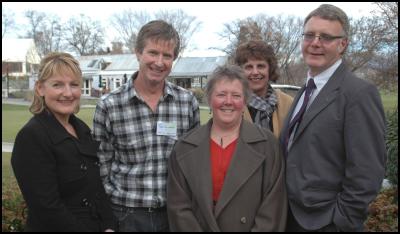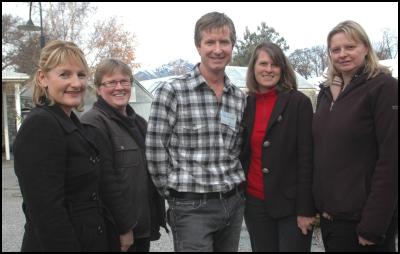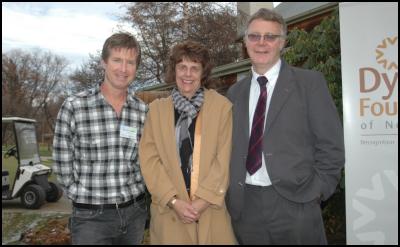Dyslexic Get ‘Permission’ To Learn Differently
Giving Dyslexic Children ‘Permission’ To Learn Differently



Teachers from 15 schools around the Queenstown and Central Otago district and interested parents gathered at Millbrook Resort on Saturday (June 5) to hear from one of the world’s foremost thinkers on dyslexia.
In a three-hour workshop, UK-based Neil MacKay demonstrated how youngsters with dyslexia needed to be given “permission” to learn differently, and how changing the learning process in schools could not only benefit those with dyslexia, but all children in the classroom.
“If we can personalise the learning process, they all learn so much better,” he said.
Mr MacKay is the creator of Britain’s Dyslexia Friendly Schools concept. Approximately one in ten New Zealanders have dyslexia, including 70,000 schoolchildren.
Sponsored by Millbrook Resort and the Queenstown Cookie Time store, which supports the Dyslexia Foundation through the Cookie Time Charitable Trust, the seminar got the thumbs up from teachers and parents attending.
Shirley Forrest, a specialist support teacher from Arrowtown Primary School, described Mr MacKay’s simple, easy techniques as “fantastic”.
“We used to think that many children who were struggling in the classroom simply needed more ‘one-on-one’ time, more of the same. Now we know they need something quite different and far more specific and tailor-made.”
Kay Hart of Mt Aspiring College in Wanaka said Mr MacKay’s methods of working with dyslexic children were “essential learning” for teachers and parents.
“It’s a real uphill battle to get some schools involved but it must be done,” she said. “When you see the change in a child’s self confidence when they realise that they are able to ‘think’ and ‘do’ and that the words don’t matter so much, it’s very invigorating.”
Jan Rockliff, who works at Cromwell College and has a dyslexic child attending Goldfields Primary School, said school was “terrifying” for her child, who saw it as hard work for very little reward.
“It can be incredibly frustrating being a parent because there doesn’t appear to be anything you can do to help them, but the seminar gave me a great insight into how dyslexic children see things and the whole confusion they feel.
“This is the first time I’ve seen and heard about a simple process of learning that can be introduced in manageable bite sizes while also making it fun for your child.”
In a draw, Goldfields Primary School and Wakatipu High School were both awarded $1750 from the Dyslexia Foundation of New Zealand and the Cookie time Queenstown store to help further their efforts to become ‘dyslexia friendly’.
Dyslexia Foundation trustee Guy Pope-Mayell said it not only made sense for schools to become dyslexia friendly, but for workplaces as well.
“This is a whole new approach aimed at recognising dyslexia as a learning preference. Seeing it as a preference means that you can do something about it.
“If you apply this to the workplace, when you ask people to communicate only by email, where does that leave the person who wants to come and knock on your door and tell you what they think?”
Mr Pope-Mayell said there were 500 schools around New Zealand that had adopted the foundation’s 4D programme.
“In the classroom, if we get it right for dyslexic children, then we get it right for all. And for parents, we help them to celebrate what will work, and ignore what won’t.”
Further information on dyslexia is available from the Dyslexia Foundation’s website www.dfnz.org.nz and details about Neil MacKay, his workshops, and the foundation’s 4D programme is available from www.4d.org.nz.
ENDS


 Milford Foundation: Milford Foundation Commits Additional $460k Of Support To University Students
Milford Foundation: Milford Foundation Commits Additional $460k Of Support To University Students Te Tuhi Mareikura Trust: Nominations Open On Friday 31st January- Celebrate Artistic Excellence At Ngā Tohu Toi 2025!
Te Tuhi Mareikura Trust: Nominations Open On Friday 31st January- Celebrate Artistic Excellence At Ngā Tohu Toi 2025! Asthma and Respiratory Foundation: Hospitalisation Spike Likely During Back-To-School Period
Asthma and Respiratory Foundation: Hospitalisation Spike Likely During Back-To-School Period NZ Symphony Orchestra: NZSO To Perform Timeless Baroque Masterpieces In Eight-date March Tour
NZ Symphony Orchestra: NZSO To Perform Timeless Baroque Masterpieces In Eight-date March Tour PSA: One Week On, New Health Minister Must Lift Hiring Freeze And Start Delivering
PSA: One Week On, New Health Minister Must Lift Hiring Freeze And Start Delivering Pharmacy Council: New Pharmacy Council Disciplinary Levy And Annual Practising Certificate Fee
Pharmacy Council: New Pharmacy Council Disciplinary Levy And Annual Practising Certificate Fee